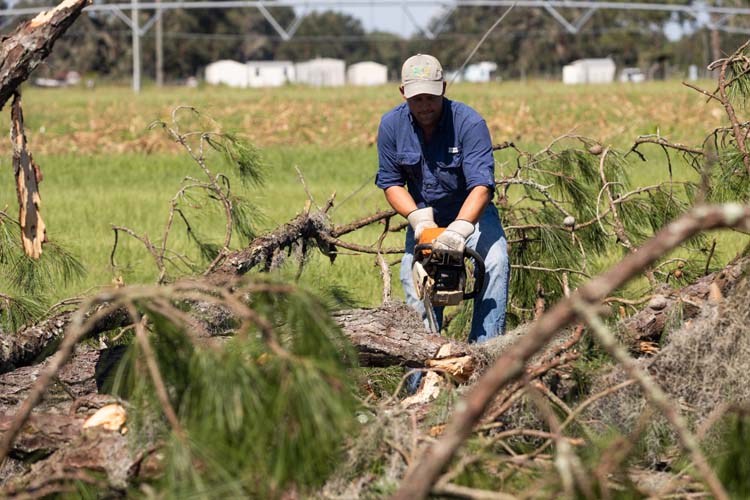Jim Cantore rides out Idalia in UF/IFAS facility in Cedar Key
UF/IFAS facilities rebuild from Hurricane Idalia with help from volunteers, emergency response crews

Jim Cantore, center, talks with UF/IFAS personnel during a cleanup of Cedar Key. -Photo: UF-IFAS
Meredith Bauer / SVT Staff
Cedar Key, Fla., – When Hurricane Idalia barreled through the Big Bend region of Florida, Mike Allen was stuck in Gainesville, watching a beloved UF/IFAS facility, Nature Coast Biological Station in Cedar Key, get slammed by storm surge while The Weather Channel’s Jim Cantore reported from the facility’s second-story patio.
Once the rain stopped and the wind subsided after the storm rushed through on Aug. 30, University of Florida Institute of Food and Agricultural Sciences (UF/IFAS) employees took stock of what the Category 3 hurricane had done: A lab with smashed equipment. Trees snapped like toothpicks. Greenhouses bent and their coverings shredded. No UF/IFAS employees were hurt in the storm.
And nearly as quickly – as soon as the storm surge retreated and the wind stopped – UF/IFAS volunteers loaded into cars and created caravans on the way to the facilities hit worst by the storm.
Volunteers mopped muck at the Nature Coast Biological Station (NCBS) in Cedar Key, and chainsawed fallen trees at the North Florida Research and Education Center in Live Oak and at Florida 4-H’s Camp Cherry Lake in Madison.
Mike Allen, director of the Nature Coast Biological Station in Cedar Key said in a video, Jim Cantore and the crew from The Weather Channel were in Cedar Key having dinner at Steamers before Idalia hit. They told the waitress, Leanna, they were looking for a place to film. She contacted Allen and they made it happen.
“Our building is not a storm shelter and we actually typically do not have anyone ride a storm out in there, including me,” Allen said. “Even though it’s built for a category 4 storm. It’s a safe place but when you get an event like this, there’s nowhere to go because there is water all underneath.” So Cantore and his crew were able to use the facility to demonstrate the effects of storm surge on the communities. “They had great visuals of the coast and great visuals of the town.”

A volunteer uses a chainsaw at the North Florida Research Education Center -- Suwannee Valley. -Photo: Uf-IFAS














